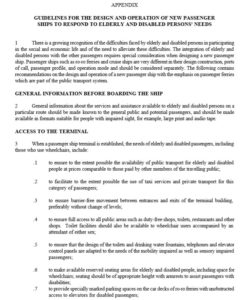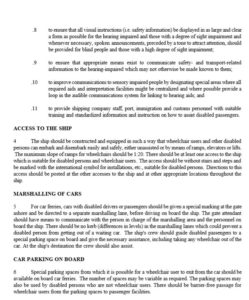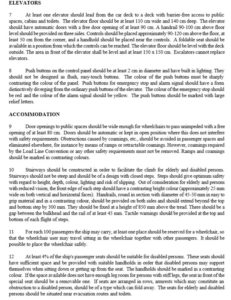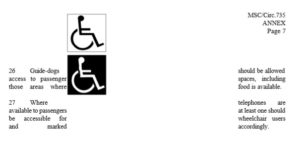A) Introduction
This chapter deals with legislation that is relevant for maritime transport, including procurements and others. The overview concerns Norwegian legislation, ordered according to topic. At the end of the chapter international legislation is presented, including EU Directives which are or will be implemented in Norway pending the decision of the Storting.
B) Accessibility and antidiscrimination legislation
B1) Act relating to equality and a prohibition against discrimination (Equality and Anti-Discrimination Act)
The Equality and Anti-Discrimination Act came into force on 1 January 2018 and covers all grounds of discrimination, including discrimination on the basis of disability. Universal design and individual facilitation (see definitions in Chapter 2) are covered by Chapter 3 Universal design and individual facilitation. There are three paragraphs that require universal design, and four paragraphs that address requirements for individual facilitation. The chapter has the following provisions:
Section 17.Universal design
Public undertakings and private undertakings focused on the general public have a duty to ensure that their general functions have a universal design.
«Universal design» means designing or accommodating the main solution with respect to the physical conditions, including information and communications technology (ICT), such that the general functions of the undertaking can be used by as many people as possible, regardless of disability.
The duty does not apply to design or accommodation that imposes a disproportionate burden on the undertaking. In the assessment, particular weight shall be given to
- a) the effect of dismantling barriers for persons with disabilities
- b) whether the general functions of the undertaking are of a public nature
- c) the costs associated with accommodation
- d) the undertaking’s resources
- e) safety considerations
- f) cultural heritage considerations.
The duty pursuant to the first paragraph is deemed to be met if the undertaking fulfils universal design requirements in laws or regulations.
The King may issue regulations on the content of the duty to ensure universal design in areas that are not covered by requirements in other laws or regulations.§ 18 tar opp plikten til universell utforming av IKT (se avsnitt på lovgivning og IKT).
Section 19 Duty to actively work to promote universal design takes up the duty of activity in relation to universal design: “Public enterprises shall work actively and purposefully to promote universal design within the business. The same goes for private businesses aimed at the general public.”
Section 20 deals with the duty to individually facilitate municipal services.
Section 21 deals with individual facilitation for students and students.
Section 22 deals with individual facilitation for job seekers and workers.
Section 23 deals with individual facilitation for pregnant job seekers, workers, pupils and students.
C) Relevant legislation for universal design of ships
C1) Forskrift om bygging av skip (FOR-2016-12-27-1884) (Regulation on building of ships – Norwegian only)
Kapittel 2. Utfyllende sikkerhetsregler
- 7.Krav til universell utforming i passasjerskip
(1) Passasjerskip skal oppfylle kravene etter MSC.1/Circ.735 (Se B)) til universell utforming og sikkerhet for personer med nedsatt funksjonsevne med de tilpasninger som kreves for skipet.
(2) Passasjerskip som er bygget 1. januar 2010 eller senere skal oppfylle følgende krav:
- a) Skipet skal være konstruert og utstyrt slik at personer med nedsatt funksjonsevne kan stige ombord og gå i land på en enkel og sikker måte, og – så langt det er mulig – forflytte seg mellom dekkene, enten på egen hånd eller ved hjelp av ramper eller heiser. Det skal settes opp anvisninger til slike adgangsfasiliteter ved alle innganger og andre hensiktsmessige steder ombord på hele skipet.
- b) Skilt ombord til hjelp for passasjerene skal være universelt utformet, strategisk plassert og lett å lese for personer med nedsatt funksjonsevne (se også pkt. 4.3).
- c) Skipet skal være utstyrt med hjelpemidler for å kommunisere viktige meldinger til personer med nedsatt funksjonsevne, f.eks. meldinger om forsinkelse, ruteendringer og tjenester ombord.
- d) Alarmsystem og -knapper skal være utformet slik at de lett kan nås av alle og at alle kan varsle. Alarmsignalet skal kunne oppfattes av alle uavhengig av funksjonsevne.
- e) Håndlister, korridorer og ganger, døråpninger, dører, heiser, bildekk, passasjersalonger, innredning og toaletter skal være konstruert slik at de i rimelig omfang og på en rimelig måte er universelt utformet.
(3) For passasjerskip bygget før 1. januar 2010 gjelder kravene i første og andre ledd bare når ombygging og reparasjoner medfører større forandringer og endret utrustning av områder hvor passasjerer har alminnelig adgang.
- 63.Rømningsveier med ledelys på passasjerskip
(1) Passasjerskip skal ha rømningsveier som hele veien skal merkes med belysning eller lysende striper som er plassert ikke mer enn 0,3 meter over dekket.
(2) Merkingen etter første ledd skal gjøre det mulig for passasjerene å identifisere alle rømningsveier og hurtig gjenkjenne rømningsutgangene. Når det brukes elektrisk belysning, skal denne være i samsvar med retningslinjer fastsatt i IMO resolusjon A.752 (18).
C2) Forskrift om besiktelse, bygging og utrustning av passasjerskip i innenriks fart (FOR-2000-03-28-305) (Regulation on inspection, construction and equipment of passenger ships in domestic traffic – Norwegian version only)
Kapittel 4. Tekniske og utstyrsmessige krav
- 8D.Sikkerhetskrav for bevegelseshemmede personer
(1) MSC sirkulære nr. 735 av 24. juni 1996 (se B)) om anbefalinger med hensyn til passasjerskips konstruksjon og drift for å imøtekomme eldre og bevegelseshemmede personers behov (Recommendation on the design and operation of passenger ships to respond to elderly and disabled persons’ need) skal følges i den utstrekning det passer.
(2) For passasjerskip i klasse A, B, C og D som ble kjølstrukket eller som var på et tilsvarende byggetrinn på eller etter 1. oktober 2004 gjelder følgende:
- a) Atkomst til skipet
Skipene skal være konstruert og utstyrt slik at bevegelseshemmede personer kan stige ombord og gå i land på en enkel og sikker måte, og forflytte seg mellom dekkene, enten på egen hånd eller ved hjelp av ramper eller heiser. Det skal settes opp anvisninger til slike adgangsfasiliteter ved alle innganger og andre hensiktsmessige steder ombord på hele skipet.
- b) Skilt
Skilt som finnes ombord på et skip til hjelp for passasjerene, skal være tilgjengelige og lette å lese for bevegelseshemmede personer (herunder personer med sensoriske funksjonshemninger), og være strategisk plassert, se også punkt 4.3).
- c) Kommunikasjon og meldinger
Fartøyet skal være utstyrt med midler ombord til å kommunisere meldinger visuelt og verbalt, f.eks. om forsinkelser, ruteendringer og tjenester ombord, til personer med ulike former for bevegelseshemninger.
- d) Alarm
Alarmsystem og -knapper må være utformet slik at de lett kan nås av og varsle alle bevegelseshemmede personer, herunder personer med sensoriske svekkelser og personer med lærevansker.
- e) Tilleggskrav for å sikre bevegelighet inne i skipet
Håndlister, korridorer og ganger, døråpninger og dører skal være tilgjengelige for rullestolbrukere. Heiser, bildekk, passasjersalonger, innredning og toaletter skal være konstruert slik at de på en rimelig måte og i rimelig omfang er tilgjengelige for bevegelseshemmede personer.
(3) For passasjerskip i klasse A, B, C og D som ble kjølstrukket eller som var på et tilsvarende byggetrinn før 1. oktober 2004 gjelder første og andre ledd i paragrafen her ved ombygging og i den utstrekning Sjøfartsdirektoratet bestemmer, jf. § 1 tredje ledd.
Tilføyd ved forskrift 2 des 2004 nr. 1561.
C3) Lov 16. februar 2007 nr. 9 om skipssikkerhet (skipssikkerhetsloven) (Law on ship safety – available in Norwegian only)
Loven gjelder for norske skip i alle farvann og for utenlandske skip i norsk territorialfarvann med de begrensninger som følger av folkeretten. Loven omhandler blant annet tekniske og operative krav til skip.
Et skip skal være prosjektert, bygget og utrustet på en slik måte at det ut fra skipets formål og fartsområde gir betryggende sikkerhet for liv og helse, miljø og materielle verdier (§ 9). Passasjerskip kan bygges etter flere ulike forskrifter, avhengig av type fartøy og fartsområde:
- Forskrift 1. juli 2014 nr. 1072 om bygging av skip
- Forskriften gjelder passasjerskip på internasjonal reise og passasjerskip i innenriksfart i farvann som ikke er EØS-farvann. Forskriften gjennomfører bl.a. Sjøsikkerhetskonvensjonen (SOLAS)
- 7 gjør IMOs retningslinjer i MSC.1/Circ. 735 bindende for norske skip.
- Forskrift 28. mars 2000 nr. 305 om besiktelse, bygging og utrustning av passasjerskip i innenriks fart
- Forskriften gjelder passasjerskip i EØS-farvann, og gjennomfører bl.a. passasjerskipsdirektivet 2009/45/EF.
- 8D gjør IMOs retningslinjer i MSC.1/Circ. 735 bindende for norske skip.
- Forskrift 5. januar 1998 nr. 6 om bygging, utrustning og drift av hurtiggående fartøy som anvendes som passasjerskip eller lasteskip
- Forskriften gjelder alle hurtiggående passasjerskip på internasjonal reise og hurtiggående passasjerskip over 24 meter i innenriksfart. Forskriften gjennomfører blant annet den internasjonale hurtigbåtkoden (2000 HSC Code)
- 33 gjør IMOs retningslinjer i MSC.1/Circ. 735 bindende for norske skip.
(Vedlegg: Se B) International Maritime Organization MSC/Circ. 735 Recommendation on the design and operation of passenger ships to respond to elderly and disabled persons’ needs. MSC.1/Circ. 735)
C4) Lov 24. juni 1994 nr. 39 om sjøfarten (sjøloven) (Law on maritime traffic – available in Norwegian only)
Sjøloven er en av de mest sentrale lovene innen sjøretten, det vil si de rettsregler som angår skipsfart og sjøveis transport. Loven regulerer først og fremst privatrettslige spørsmål knyttet til skip og transport av gods og personer med skip.
- 418a gjennomfører Europaparlaments- og rådsforordning (EU) nr. 1177/2010 av 24. november 2010 om passasjerenes rettigheter ved sjøreiser og reiser på indre vannveier og om endring av forordning (EF) nr. 2006/2004.
(Vedlegg: Se Europaparlamentets og Rådets forordning (EU) Nr. 1177/2010 af 24. november 2010 om passagerers rettigheder ved sørejser og rejser på indre vandveje og om ændring af forordning (EF) nr. 2006/2004.)
- 418 gjennomfører Europaparlaments- og rådsforordning (EF) nr. 392/2009 av 23. april 2009 om transportørers erstatningsansvar ved ulykker under sjøtransport av passasjerer.
(Vedlegg: Se Europaparlamentets og Rådets forordning (EF) Nr. 392/2009 af 23. april 2009 om transportørers erstatningsansvar ved ulykker under søtransport af passagerer)
D) Relevant legislation on universal design of infrastructure
D1) Lov om planlegging og byggesaksbehandling (plan- og bygningsloven) (Norwegian planning- and building Act – available in Norwegian only)
Parts of the Planning and Building Act is available in English: https://dibk.no/globalassets/byggeregler/the-planning-and-building-act.pdf and https://www.regjeringen.no/en/dokumenter/planning-building-act/id570450/.
Plan- og bygningsloven tar opp krav til universell utforming av byggverk, som er spesifisert i Teknisk Forskrift til plan- og bygningsloven (TEK 17).
Lov om planlegging og byggesaksbehandling (plan- og bygningsloven) trådte i kraft 1. januar 2013. Den er sentral for krav til bygninger knyttet til transport. § 1-1 Lovens formål sier bl.a. at: «Prinsippet om universell utforming skal ivaretas i planleggingen og kravene til det enkelte byggetiltak».
I loven er det stilt krav om at byggverk for publikum, arbeidsbygning og uteområder for allmenheten skal være universelt utformet. Videre har loven flere relevante bestemmelser for:
- § 11-9.Generelle bestemmelser til kommuneplanens arealdel, pkt. 5 sier at (Kommunen kan uavhengig av arealformål vedta bestemmelser til kommuneplanens arealdel om:) byggegrenser, utbyggingsvolum og funksjonskrav, herunder om universell utforming, leke-, ute- og oppholdsplasser, skilt og reklame, parkering, frikjøp av parkeringsplasser etter § 28-7 og utnytting av boligmassen etter § 31-6;
- § 12-7.Bestemmelser i reguleringsplan sier at: I reguleringsplan kan det i nødvendig utstrekning gis bestemmelser til arealformål og hensynssoner om følgende forhold: Pkt. 4 funksjons- og kvalitetskrav til bygninger, anlegg og utearealer, herunder krav for å sikre hensynet til helse, miljø, sikkerhet, universell utforming og barns særlige behov for leke- og uteoppholdsareal,
- krav til universell utforming og forsvarlighet (§ 29-3), sier at: Tiltak etter kapittel 20 skal innenfor sin funksjon være universelt utformet i samsvar med forskrifter gitt av departementet. Tiltak etter kapittel 20 som omfatter arbeidsbygg skal være universelt utformet i samsvar med forskrift gitt av departementet.
- § 31-4.Pålegg om dokumentasjon og utbedring sier blant annet at: Departementet kan gi forskrift om kommunens adgang til å gi pålegg om dokumentasjon og utbedring av eksisterende byggverk og installasjoner
Pålegg kan bare gis der utbedring vil gi vesentlig forbedring av byggverkets eller installasjonens funksjon som tilsies av tungtveiende hensyn til universell utforming, helse, miljø, sikkerhet eller bevaringsverdi. I vurderingen skal det legges vekt på kostnadene ved pålegget, antall brukere, hvilke farer eller ulemper de utsettes for, og avstanden mellom den faktiske tilstanden og gjeldende krav.
D2) Regulations on technical requirements for construction works
The Regulations are available in an unofficial English translation: https://dibk.no/globalassets/byggeregler/regulation-on-technical-requirements-for-construction-works–technical-regulations.pdf
The Regulations on technical requirements for structures (building engineering regulations) TEK17, which came into force on 1 January 2015 is important for the field of universal design of infrastructure. It replaced TEK10 and introduced some changes and clearly defined requirements. In a transition phase until January 1, 2017, the On January 1, 2019, both TEK10 and TEK 17 apply, but you have to choose which one you want to follow, they cannot be mixed together.
Guidance on technical requirements for structures, elaborates on the requirements of building technical regulations. The relationship between them is that the regulations set minimum requirements and functional requirements, while the guidance interprets the functional requirements and provides pre-accepted benefits that will meet the requirements.
Among other things, the regulations require:
- requirements for outdoor living area (§ 8-3)
- access to structures with requirements for universal design (§ 8-6);
- access to outdoor living area with requirements for universal design (§ 8-7);
- parking plan, other line-up area and driving access to structures with requirements for universal design (§ 8-8);
- requirements for floor plan and universal design of structures (§ 12-1);
- requirements for elevator in edifices (§ 12-3);
- requirements for, among other things, that it should be easy to orient itself (§ 12-6);
- requirements for stairs and railings (§§ 12-14, 12-15)
- requirements for ramps (§ 12-16);
- requirements for window and other glass fields (§ 12-17);
- requirements for signs, control and control panel, handles, luminaires and the like (§ 12-18);
- air quality requirements (Chapter 13.I);
- requirements for sound and vibrations (Chapter 10 13.II).
E) Relevant legislation for universal design of information- and communication technology
E1) Act relating to equality and a prohibition against discrimination (Equality and Anti-Discrimination Act)
Section 18 In particular on the universal design of ICT of the Anti-Discrimination and Equality Act states that: “Solutions for ICT that underpin the general functions of the business, and which are main solutions aimed at or provided to the general public, shall be universally designed from the time set out in Section 41.
ICT means technology and systems of technology used to express, create, transform, exchange, store, multiply and publish information, or that otherwise make information applicable.
The duty does not apply to ICT solutions where the design is regulated by other law or regulation.”
E2) Forskrift om universell utforming av informasjons- og kommunikasjonsteknologiske (IKT)-løsninger (Regulations on universal design of information and communication technology (ICT) solutions – legal in Norwegian only)
The regulation came into force 2013-07-01 and are a regulation to the Equality and Anti-Discrimination Act. The purpose of the regulation is to ensure universal design of information and communication technology solutions without causing a disproportionate burden on businesses.
The regulations target businesses that inform and provide services to the general public through the use of ICT solutions, but not adaptation or facilitation of ICT solutions for individuals. Solution requirements include web solutions, which will follow the requirements of WCAG 2.0/NS-ISO/IEC 40500 Information Technology – W3C guidelines for available web content (WCAG) 2.0; and vending machines to be designed in accordance with a given list of standards/normative documents.
A revised edition of the regulations is likely to come in 2019.
F) Relevant legislation on public procurement – Norwgian legislation
F1) Lov om offentlige anskaffelser [anskaffelsesloven] (Law on public procurement (the public procurement Act – in Norwegian only)
Revidert lov om offentlige anskaffelser trådte i kraft 1.januar 2017. Følgende bestemmelser er relevante:
- 2.Oppdragsgivere som er omfattet
Loven gjelder for statlige, kommunale og fylkeskommunale myndigheter og offentligrettslige organer. Loven gjelder for rettssubjekter som driver virksomhet innenfor forsyningssektorene, i den utstrekning dette følger av internasjonale forpliktelser og forskrifter gitt i medhold av loven. Loven gjelder også for andre rettssubjekter i saker om bygge- og anleggskontrakter, dersom det offentlige yter tilskudd på mer enn 50 prosent av kontraktens verdi.
Kongen kan gi nærmere bestemmelser om hvilke oppdragsgivere som er omfattet av loven.
Kongen kan gi nærmere bestemmelser om lovens anvendelse på Svalbard og fastsette særlige regler av hensyn til de stedlige forhold.
- 3.Anskaffelser som er omfattet
Loven gjelder anskaffelser av varer, tjenester og bygge- og anleggsarbeider som foretas av oppdragsgivere som nevnt i § 2. Loven gjelder ikke anskaffelser som kan unntas etter EØS-avtalen artikkel 123.
- 6.Livssykluskostnader, universell utforming og miljø
Statlige, kommunale og fylkeskommunale myndigheter og offentligrettslige organer skal under planleggingen av den enkelte anskaffelse ta hensyn til livssykluskostnader, universell utforming og miljømessige konsekvenser av anskaffelsen.
Se også Vedlegg 2 Fra veileder til reglene om offentlige anskaffelser (anskaffelsesforskriften).
Relevant international legislation
A) EU Accessibility Act
See: https://ec.europa.eu/social/main.jsp?catId=1202.
The upcoming Accessibility Act – the EU Accessibility Act – addresses requirements for availability to ICT, such as requirements for transport, ICT and operating systems; ticket machines; smartphones; online banking; eBooks and e-commerce.[i]
Relevant for transport by ferries and speedboats, the provisions on ticketing and check-in machines, and infrastructure and services related to maritime transport, among others, become. The legislation will be linked to public procurement.
When it comes to transport, including sea transport, the upcoming legislation sets requirements for various areas (see Section V of the proposal of the EU Accessibility Act).
- Services, including information about use in available format, alternatives to non-textual content and electronic dissemination, universal design of websites and requirements for the exercise of services.
- Websites, including requirements for design and content and requirements for interoperability with various technical aids.
- Mobile applications, smart ticketing and real-time information, including user information in available formats, alternatives to non-textual content, and more.
- Self-service terminals, ticket machines and check-in machines used for transport purposes should be universally designed, including several alternative user interfaces, understandable information, available font sizes, good user interface against various technical aids, as well as options for selecting different alternative user modes.
The Accessibility Act is expected to be passed during 2020.
B) International Maritime Organization MSC/Circ. 735 Recommendation on the design and operation of passenger ships to respond to elderly and disabled persons’ needs.
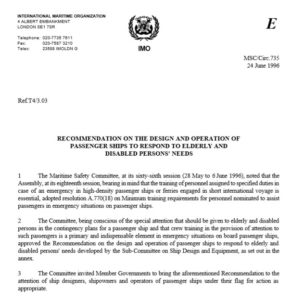
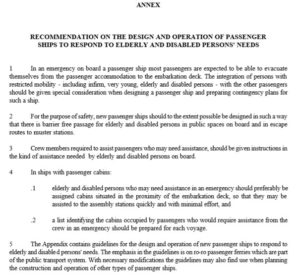
C) Europaparlamentets og Rådets forordning (EU) Nr. 1177/2010 af 24. november 2010 om passagerers rettigheder ved sørejser og rejser på indre vandveje og om ændring af forordning (EF) nr. 2006/2004
This regulation takes, among other things, up rights for passengers at as well as international sea transport, including rights for persons with disabilities. The EU Regulation was adopted from 2010-11-24 and effective in the EU/EEA from 2012-12-18.
In the introduction (preambel) section 4 it says that:
(4) ) The internal market for maritime and inland waterway passenger services should benefit citizens in general. Consequently, disabled persons and persons with reduced mobility, whether caused by disability, age or any other factor, should have opportunities for using passenger services and cruises that are comparable to those of other citizens. Disabled persons and persons with reduced mobility have the same rights as all other citizens with regard to free movement, freedom of choice and non-discrimination.
Section 6 addresses the principle of free assistance and the determination of access conditions:
6) In the light of Article 9 of the United Nations Convention on the Rights of Persons with Disabilities and in order to give disabled persons and persons with reduced mobility opportunities for maritime and inland waterway travel comparable to those of other citizens, rules for non-discrimination and assistance during their journey should be established. Those persons should therefore be accepted for carriage and not refused transport, except for reasons which are justified on the grounds of safety and established by the competent authorities. They should enjoy the right to assistance in ports and on board passenger ships. In the interests of social inclusion, the persons concerned should receive this assistance free of charge. Carriers should establish access conditions, preferably using the European standardisation system.
Section 7) advises member states to follow the principle of universal design of infrastructure in the ports:
(7) In deciding on the design of new ports and terminals, and as part of major refurbishments, the bodies responsible for those facilities should take into account the needs of disabled persons and persons with reduced mobility, in particular with regard to accessibility, paying particular consideration to ‘design for all’ requirements. Carriers should take such needs into account when deciding on the design of new and newly refurbished passenger ships in accordance with Directive 2006/87/EC of the European Parliament and of the Council of 12 December 2006 laying down technical requirements for inland waterway vessels (5) and Directive 2009/45/EC of the European Parliament and of the Council of 6 May 2009 on safety rules and standards for passenger ships.
Section 21 addresses requirements for information to passengers and mentions several alternative formats on the information:
(21) Passengers should be fully informed of their rights under this Regulation in formats which are accessible to everybody, so that they can effectively exercise those rights. Rights of passengers should include the receipt of information regarding the passenger service or cruise before and during the journey. All essential information provided to passengers should also be provided in formats accessible to disabled persons and persons with reduced mobility, with such accessible formats allowing passengers to access the same information using, for example, text, Braille, audio, video and/or electronic formats.
Article 3 Definitions reproduce the same definition of passengers with disabilities as the other transport-related regulations and directives.
Kapittel II Rights of disabled persons and persons with reduced mobility addresses several provisions that in particular relate to passengers with disabilities.
Artikkel 7 Right to transport statest:
- Carriers, travel agents and tour operators shall not refuse to accept a reservation, to issue or otherwise provide a ticket or to embark persons on the grounds of disability or of reduced mobility as such.
- Reservations and tickets shall be offered to disabled persons and persons with reduced mobility at no additional cost under the same conditions that apply to all other passengers.
Artikkel 8 Exceptions and special conditions states: :
- By way of derogation from Article 7(1), carriers, travel agents and tour operators may refuse to accept a reservation from, to issue or otherwise provide a ticket to or to embark a disabled person or person with reduced mobility:
- in order to meet applicable safety requirements established by international, Union or national law or in order to meet safety requirements established by the competent authorities;
(b) where the design of the passenger ship or port infrastructure and equipment, including port terminals, makes it impossible to carry out the embarkation, disembarkation or carriage of the said person in a safe or operationally feasible manner.
- In the event of a refusal to accept a reservation or to issue or otherwise provide a ticket on the grounds referred to in paragraph 1, carriers, travel agents and tour operators shall make all reasonable efforts to propose to the person concerned an acceptable alternative transport on a passenger service or a cruise operated by the carrier.
- Where a disabled person or a person with reduced mobility, who holds a reservation or has a ticket and has complied with the requirements referred to in Article 11(2), is nonetheless denied embarkation on the basis of this Regulation, that person, and any accompanying person referred to in paragraph 4 of this Article, shall be offered the choice between the right to reimbursement and re-routing as provided for in Annex I. The right to the option of a return journey or re-routing shall be conditional upon all safety requirements being met.
- Where strictly necessary and under the same conditions set out in paragraph 1, carriers, travel agents and tour operators may require that a disabled person or person with reduced mobility be accompanied by another person who is capable of providing the assistance required by the disabled person or person with reduced mobility. As regards passenger services, such an accompanying person shall be carried free of charge.
- When carriers, travel agents and tour operators have recourse to paragraphs 1 or 4, they shall immediately inform the disabled person or person with reduced mobility of the specific reasons therefor. On request, those reasons shall be notified to the disabled person or person with reduced mobility in writing, no later than five working days after the request. In the event of refusal according to paragraph 1(a), reference shall be made to the applicable safety requirements.
Artikkel 9 Accessibility and information states among others, regarding requirements to information that:
- In cooperation with organisations representative of disabled persons or persons with reduced mobility, carriers and terminal operators shall, where appropriate through their organisations, establish, or have in place, non-discriminatory access conditions for the transport of disabled persons and persons with reduced mobility and accompanying persons. The access conditions shall upon request be communicated to national enforcement bodies.
- The access conditions provided for in paragraph 1 shall be made publicly available by carriers and terminal operators physically or on the Internet, in accessible formats on request, and in the same languages as those in which information is generally made available to all passengers. Particular attention shall be paid to the needs of disabled persons and persons with reduced mobility.
- Tour operators shall make available the access conditions provided for in paragraph 1 which apply to journeys included in package travel, package holidays and package tours which they organise, sell or offer for sale.
- Carriers, travel agents and tour operators shall ensure that all relevant information, including online reservation and information, concerning the conditions of carriage, journey information and access conditions is available in appropriate and accessible formats for disabled persons and persons with reduced mobility. Persons needing assistance shall receive confirmation of such assistance by any means available, including electronic means or Short Message Service (SMS).
Article 10 Right to assistance in ports and on board ships obliges transport companies and port operators to provide free assistance to passengers with disabilities.
Article 11 Conditions under which assistance is provided provides the condition for passengers to receive such assistance, including that 48 hours of notice of need shall be given and that passengers who meet at the agreed location should not meet earlier than 60 minutes before the agreed meeting time. Passengers should also notify of any needs in relation to the need for the number of passengers. cabin, medical equipment and the like. There should also be room for the passenger’s service dog if agreed with the carrier, travel agent or tour operator in accordance with national rules.
Article 13 Quality standards for assistance include user participation, and requirements for information in the available format:
- Terminal operators and carriers operating port terminals or passenger services with a total of more than 100 000 commercial passenger movements during the previous calendar year shall, within their respective areas of competence, set quality standards for the assistance specified in Annexes II and III and shall, where appropriate through their organisations, determine resource requirements for meeting those standards, in cooperation with organisations representative of disabled persons or persons with reduced mobility.
- In setting quality standards, full account shall be taken of internationally recognised policies and codes of conduct concerning facilitation of the transport of disabled persons or persons with reduced mobility, notably the IMO’s Recommendation on the design and operation of passenger ships to respond to elderly and disabled persons’ needs.
- The quality standards provided for in paragraph 1 shall be made publicly available by terminal operators and carriers physically or on the Internet in accessible formats and in the same languages as those in which information is generally made available to all passengers.
Article 14 Training and instructions requires training of personnel in connection with service performance to passengers with disabilities.
Article 15 Compensation in respect of mobility equipment or other specific equipment makes claims in connection with aids that are damaged or lost and the responsibilities of the carriers and terminal operators.
Article 17 Assistance in the event of cancelled or delayed departures requires that such information be disseminated in the available format under the special consideration of passengers with disabilities.
Article 22 Right to travel information and Article 23 Information on passengers rights make the same claim as Article 17.
Appendix I Right to reimbursement or re-routing for disabled persons and persons with reduced mobility as referred to in Article 8 addresses opportunities for compensation to passengers with disabilities, e.g. alternative transport, reimbursement of expenses and opportunities for coverage of costs if the passenger must be transported to the original destination if one has had to change the itinerary.
Appendix II Assistance in ports, including embarkation and disembarkation, as referred to in Articles 10 and 13 elaborates on the requirements of carriers and port operators in terms of assistance as well as availability of different facilities.
Appendix III Assistance on board the ships, cf. Articles 10 and 13 elaborates on similar requirements for the carrier in terms of assistance to be provided when passengers with disabilities are on board ships.
Appendix IV Handicap related training, including instructions, cf. Article 14 elaborates on the requirements to be made for training personnel on board ships in connection with services to passengers with disabilities.
The Directive has now been adopted in the EEA Agreement in the decision of 2015-04-30.
D) REGULATION (EC) No 392/2009 OF THE EUROPEAN PARLIAMENT AND OF THE COUNCIL of 23 April 2009 on the liability of carriers of passengers by sea in the event of accidents
Article 4 Compensation in respect of mobility equipment or other specific equipment requires that:
In the event of loss of, or damage to, mobility equipment or other specific equipment used by a passenger with reduced mobility, the liability of the carrier shall be governed by Article 3(3) of the Athens Convention. The compensation shall correspond to the replacement value of the equipment concerned or, where applicable, to the costs relating to repairs.
- Directive (EU) 2016/2102 of the European Parliament and of the Council of 26 October 2016 on the accessibility of the websites and mobile applications of public sector bodies (Text with EEA relevance )
This directive, which came into force on September 23, 2018, addresses requirements for public websites and mobile applications. The Directive shall approximate the laws and administrative provisions of the EEA countries regarding accessibility requirements for public websites and mobile applications.
The Directive probably enters into force in Norway through the EEA Agreement 01. July 2020[ii].
It does not include private public service providers, or non-governmental organizations that do not provide services that are essential to the public or are particularly relevant to people with disabilities. It also does not include document format published before September 30, 2018, unless they are necessary for administrative processes in connection with the tasks included by a public enterprise.
The Directive requires member states to ensure that public bodies ensure that websites and mobile applications are available by making them “easy to perceive, usable and robust.”
Article 5 provides exemptions for the requirements of disproportionate burden for public bodies, due to the size, resources and tasks of the organ, costs in relation to gains in relation to the number of persons with disabilities who may benefit from Measures.
Article 7 provides a duty of activity for public bodies, which shall regularly make a statement on the availability of their own website and mobile applications and ensure that there is a system for feedback and evaluation of the websites and mobile applications.
Article 8 requires member states to monitor and report on the accessibility of public websites and mobile applications, conducted by expert analysis.
Article 9 requires member states to have a good procedure for enforcement of the Directive and have a separate government-appointed body to provide for this.
Article 12 sets the deadline for the introduction of the Directive until 23 September 2018. Otherwise, the following applies:
- The requirements apply to new websites, published 23.09.2018 or later, 1 year after the legislation is established. That is, new sites should be universally designed from 23.09.2019.
- The requirements apply to existing websites published before 23.09.2018, 2 years after the legislation is established. That is, existing websites should be universally designed from 23.09.2020.
- For mobile applications, the requirements will apply 2 years and 9 months after the legislation is established. That is, say, mobile applications should be universally designed from 23.06.2021.
The EU has also initiated work on creating an updated European standard (EN 301549), which will elaborate on the requirements of the Directive both in terms of requirements for websites and to mobile applications, which were not previously adequately covered. The standard will also apply in Norway.
[i] Se https://eur-lex.europa.eu/legal-content/EN/TXT/?uri=COM:2015:0615:FIN .
[ii] Se https://uu.difi.no/nyhet/2018/09/eus-webdirektiv-blir-en-del-av-norsk-regelverk for mer informasjon.


